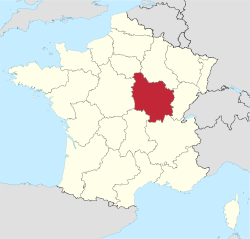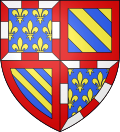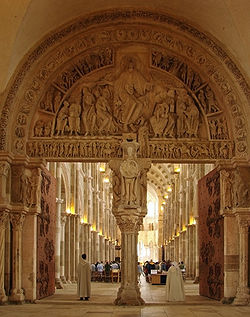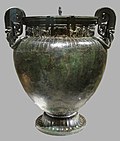Burgundy
Burgundy (French: [Bourgogne] Error: {{Lang}}: text has italic markup (help)) is a former administrative region of France. It is now part of the administrative region of Bourgogne-Franche-Comté. It was also a historic region in eastern France. The French adjective and name of the inhabitants of the region is Bourguignon.
|
Bourgogne | |
|---|---|
 | |
| Coordinates: 47°00′N 4°30′E / 47.000°N 4.500°ECoordinates: 47°00′N 4°30′E / 47.000°N 4.500°E | |
| Country | |
| Dissolved | 2016-01-01 |
| Prefecture | Dijon |
| Departments | 4
|
| Government | |
| • President | François Patriat (PS) |
| Area | |
| • Total | 31,582 km2 (12,194 sq mi) |
| Population (2008-01-01) | |
| • Total | 1,631,000 |
| • Density | 51.643/km2 (133.76/sq mi) |
| Time zone | UTC+01:00 (CET) |
| • Summer (DST) | UTC+02:00 (CEST) |
| ISO 3166 code | FR-D |
| GDP (2012)[1] | Ranked 16th |
| Total | €42.7 billion (US$55.0 bn) |
| Per capita | €25,996 (US$33,436) |
| NUTS Region | FR2 |
| Website | cr-bourgogne.fr |
With over 31,500 square kilometres (12,200 sq mi), it is one of the largest region of France. It covers about 6% of the territory of the country.
The four departments in the region were Côte-d'Or, Nièvre, Saône-et-Loire and Yonne. Its capital was Dijon.
History
Burgundy was named for the Germanic Burgundian tribe who moved there from an island in the Baltic Sea. They moved when the Roman Empire fell apart to set up a kingdom with its own laws. This included part of what is now Switzerland.
During the Middle Ages, Burgundy was ruled by dukes. In the 15th century it was very powerful. The dukes ruled lands as far north as the Netherlands. After Duke Charles the Bold died when he wanted to conquer the city of Nancy in 1477, France took southern Burgundy. It was a province until 1790. The House of Habsburg got the northern part, which later became the Southern Netherlands.
Geography
The Burgundy region is one of the largest regions of Metropolitan France. It has an area of 31,582 km2 (12,194 sq mi).[2] It bordered with five other regions: Champagne-Ardenne to the north, Franche-Comté to the east, Rhône-Alpes to the southeast, Auvergne to the southwest, Centre-Val de Loire to the west and Île-de-France to the north.
Most of the territory of Burgundy is occupied by a plateau of low hills (the Burgundy Hills) surrounded by valleys of the main rivers. The valley of the Yonne river and its tributaries is to the north of the region. To the southeast is the valley of the Saône river.
In the centre of the plateau (and of the region), there is a group of low mountains: the Morvan. The highest point in Burgundy, the Haut-Folin (46°59′46″N 4°02′13″E / 46.99611°N 4.03694°E), is in these mountains, in the Saône-et-Loire department. It is 901 m (2,956 ft) high.[3]
The main rivers of the region are Yonne, Armançon, Loire, Seine and Saône.
The climate of Burgundy is an oceanic climate with temperate summers, "Cfb" (Marine West Coast Climate) in the Köppen climate classification.
Departments
The Burgundy region is formed by four departments:
| Département | Préfecture | ISO 3166-2 |
Population (2012)[4] |
Area (km²) |
Density (Inh./km²) |
|---|---|---|---|---|---|
| Côte-d'Or | Dijon | FR-21 | 527,403 | 8,763 | 60.2 |
| Nièvre | Nevers | FR-58 | 216,786 | 6,817 | 31.8 |
| Saône-et-Loire | Mâcon | FR-71 | 555,039 | 8,575 | 64.7 |
| Yonne | Auxerre | FR-89 | 341,902 | 7,427 | 46.0 |
Demographics
The Burgundy region has a population, in 2012, of 1,641,130, for a population density of 52.0 inhabitants/km2.

The ten main cities in the region are:
| City | Population (2012)[4] |
Départment |
|---|---|---|
| Dijon | 152,071 | Côte-d'Or |
| Chalon-sur-Saône | 44,564 | Saône-et-Loire |
| Nevers | 35,327 | Nièvre |
| Auxerre | 35,096 | Yonne |
| Mâcon | 32,917 | Saône-et-Loire |
| Sens | 25,106 | Yonne |
| Le Creusot | 22,574 | Saône-et-Loire |
| Beaune | 21,806 | Côte-d'Or |
| Montceau-les-Mines | 18,956 | Saône-et-Loire |
| Autun | 14,124 | Saône-et-Loire |
Economy
The region is known for its wines, both red and white. Many well-known wines, such as Macon and Beaujolais, were first made here. A few wines are also the 'Arbois'-type. Arbois wines are between red and white and almost yellow in colour.
Gallery
Place du Bareuzai, Dijon.
Haut-Folin - View from Mont Beuvray
View of Saône River in Chalon sur Saône, Saône-et-Loire.
Church in Semur-en-Brionnais, Saône-et-Loire.
Verrerie Street, Dijon.
Burgundy Media
Coat of arms of the second Duchy of Burgundy and later of the province
Military flag of the Burgundian State during the reign of Charles the Bold
Chardonnay vineyards in the south of Côte de Beaune surrounding the town of Meursault
Poem in Burgundian dialect
References
- ↑ "La fusion Bourgogne Franche-Comté, « étape obligée » avant l'élargissement au Grand Est". www.tracesecritesnews.fr (in français). Retrieved 2020-07-21.
- ↑ "France: Bourgogne [Burgundy]". City Population. Retrieved 1 October 2014.
- ↑ "Haut Folin, France". Peakbagger.com. Retrieved 1 October 2014.
- ↑ 4.0 4.1 "Populations légales 2012 des départements et des collectivités d'outre-mer" (in French). Institut national de la statistique et des études économiques - INSEE. Retrieved 28 April 2015.
{{cite web}}: CS1 maint: unrecognized language (link)
Other websites
| Wikimedia Commons has media related to Lua error in Module:Commons_link at line 62: attempt to index field 'wikibase' (a nil value).. |
- Regional Council of Burgundy official website Archived 2016-01-13 at the Wayback Machine (in French)
- Official website of Tourism of Burgundy (in French)
- Netbourgogne.com
- About-France.com: BURGUNDY - a short guide
















